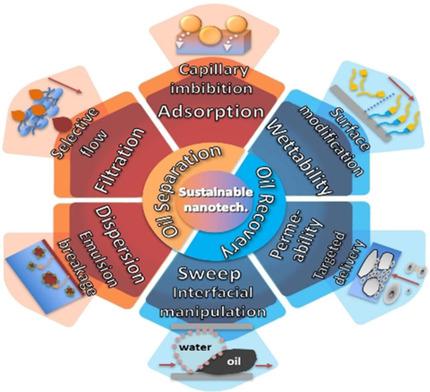当前位置:
X-MOL 学术
›
ChemNanoMat
›
论文详情
Our official English website, www.x-mol.net, welcomes your feedback! (Note: you will need to create a separate account there.)
Engineered Nanomaterials for Sustainable Oil Separation and Recovery
ChemNanoMat ( IF 3.8 ) Pub Date : 2020-09-03 , DOI: 10.1002/cnma.202000385 Mohammad Alsoraya 1 , Mingyu Zhao 1 , Donglei (Emma) Fan 1, 2
ChemNanoMat ( IF 3.8 ) Pub Date : 2020-09-03 , DOI: 10.1002/cnma.202000385 Mohammad Alsoraya 1 , Mingyu Zhao 1 , Donglei (Emma) Fan 1, 2
Affiliation

|
In this review, we focus on engineered nanomaterials (NMs) offering economic and environmental sustainability in oil extraction. We introduce underlying issues in oil recovery and separation and discuss fundamental physical and chemical interactions in typical oil‐water‐solid systems that guide the design of NMs. In recovery, the NMs change rock wettability, permeability, or sweep fluid properties to attain optimal resource use and minimal environmental impact. Applied NMs include nanosurfactants, silica core‐shell structures, nano‐encapsulated acids, and nanofluids. While for separation, the NMs use mechanisms of adsorption, filtration, or dispersion to improve separation performance in industrial or aquatic oil spill settings. The NMs include iron oxide nanoparticles, graphene Joule‐heating sponges, superhydrophilic poly(vinylidene fluoride) membranes, and amphiphilic Janus silicon dioxide nanoparticles. Albeit the NMs exhibit impressive performance in sustainable oil extraction, a technological gap remains between the lab‐scale demonstrations and practical field deployment. We conclude with a perspective on bridging this gap.
中文翻译:

工程纳米材料可实现可持续的油分离和回收
在本文中,我们将重点放在工程纳米材料(NMs)上,以提供石油开采中的经济和环境可持续性。我们介绍了采油和分离中的基本问题,并讨论了指导NM设计的典型油-水-固体系统中的基本物理和化学相互作用。在恢复过程中,NMs会改变岩石的润湿性,渗透性或清除流体的特性,从而获得最佳的资源利用和最小的环境影响。应用的NM包括纳米表面活性剂,二氧化硅核壳结构,纳米囊封的酸和纳米流体。在分离过程中,NM使用吸附,过滤或分散机制来提高工业或水生溢油环境中的分离性能。NM包括氧化铁纳米颗粒,石墨烯焦耳加热海绵,超亲水性聚偏二氟乙烯膜和两亲性Janus二氧化硅纳米粒子。尽管NM在可持续采油方面表现出色,但在实验室规模的演示和实际的现场部署之间仍然存在技术差距。我们以弥合这一差距的观点作为结束。
更新日期:2020-11-06
中文翻译:

工程纳米材料可实现可持续的油分离和回收
在本文中,我们将重点放在工程纳米材料(NMs)上,以提供石油开采中的经济和环境可持续性。我们介绍了采油和分离中的基本问题,并讨论了指导NM设计的典型油-水-固体系统中的基本物理和化学相互作用。在恢复过程中,NMs会改变岩石的润湿性,渗透性或清除流体的特性,从而获得最佳的资源利用和最小的环境影响。应用的NM包括纳米表面活性剂,二氧化硅核壳结构,纳米囊封的酸和纳米流体。在分离过程中,NM使用吸附,过滤或分散机制来提高工业或水生溢油环境中的分离性能。NM包括氧化铁纳米颗粒,石墨烯焦耳加热海绵,超亲水性聚偏二氟乙烯膜和两亲性Janus二氧化硅纳米粒子。尽管NM在可持续采油方面表现出色,但在实验室规模的演示和实际的现场部署之间仍然存在技术差距。我们以弥合这一差距的观点作为结束。



























 京公网安备 11010802027423号
京公网安备 11010802027423号